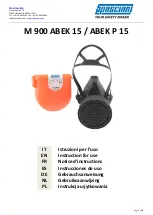
LOKAL 400 Operating Manual
Page 31
16.1.1,3 Current-induced Sound
Current-borne sound is generated at narrow points or bottlenecks, for example at valves that are only half or partly open, at
household connecting points where pipes can have different diameters or dimensions or when corrosion has formed and pipes
are crusted in rust on the inside. These factors can cause turbulent currents which can generate frequencies of over 4,000Hz.
16.1.1.4 Interference Factors
Sounds from surrounding sources that have been absorbed and filtered by the ground have a frequency spectrum similar to the
sound that a leak generates. The interference this causes can be likened to stop-and-go traffic on the roads, but with the
difference that such a traffic situation is far more disruptive with regard to traffic-flow when it happens on a country road than
somewhere in the city centre. The higher the pressure in the pipe on which an inspection is to be carried out, the higher the
amount of energy that forms at the leak. This means that leaks become less audible if the pressure in the pipe is lower than 3
bar. If the pressure is lower than 1.5 bar, a leak cannot be heard even when it is in the close vicinity.
16.1.2. Schematic Leak Detection
In order to keep costs down, it often makes sense to adopt a systematic approach to carrying out leak detection. This is
especially true when water pipes are concerned, for example. The first thing you need to know is the course of the pipe. You
will also need to differentiate clearly between the
preliminary leak detection stage
and the
stage which involves pinpointing the
actual leak
. If this first stage is not performed, the whole length of the pipe will have to be inspected in order to determine the
exact location of the leak.
16.1.2.1 Narrowing Down the Leak by Using a Stick Microphone
You can narrow down the position of a leak by inspecting the parts of the pipe system which you are able to access with the
probe tip of the stick microphone. Particular attention must be paid to the type of sound which is recorded: leaks generate a dull,
muffled sound and valves produce a brighter, sharper sound. Both sounds are very helpful when it comes to narrowing down the
position of a leak, but it is important to remember that similar sounds
– like that of water flowing through a pipe – can be
generated when water is taken from the pipe via a tap for example. When narrowing down the leak, it is important to ensure that
no value exceeds the range on the display, as otherwise you will not be able to identify the actual maximum value. The fact that
the measuring values can be saved into the internal memory is an added benefit, as they can then be “carried over“ to the place
where measuring is to be carried out next. This method allows you to determine the particular pipe section with the highest
sound level without changing the control settings. The next leak detection stage is then to be carried out on this particular pipe
section over ground.
16.1.2.2 Pinpointing the Leak by Using a Ground Microphone
If you have managed to detect a defective pipe section using the stick microphone, you can use the ground microphone to
pinpoint the leak. Always make sure that the distance between any two points that you have selected for the ground microphone
are not too far apart as otherwise you might miss the leak. As a rule, the distance apart should not be more than one metre.

































